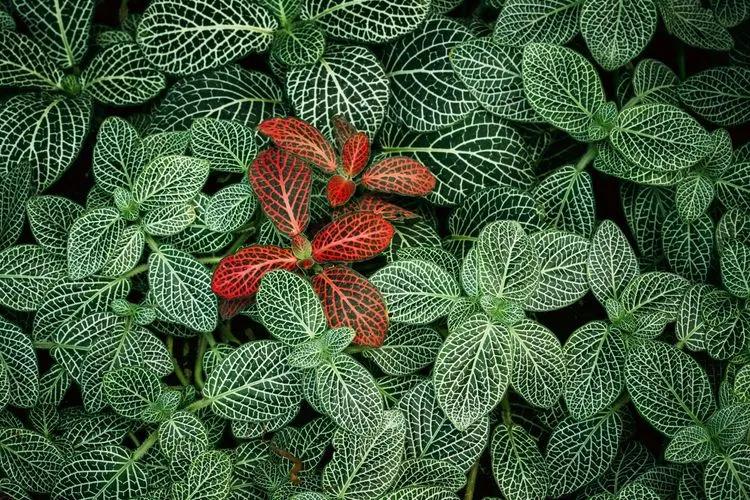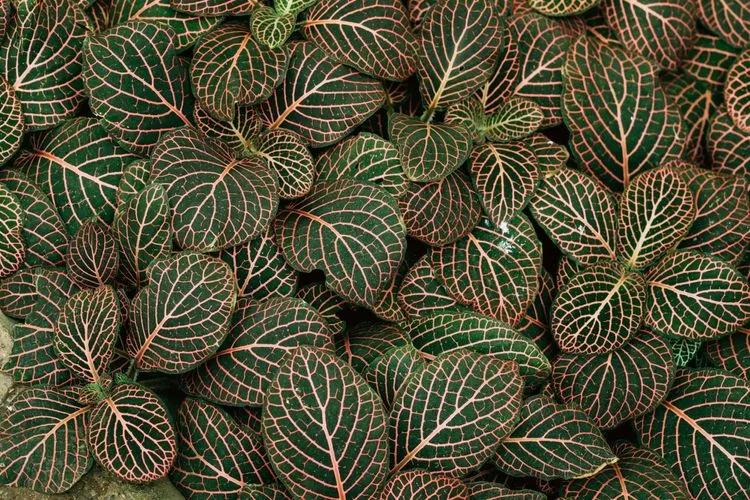 Fittonia argyroneura plants have a very tender look due to their delicately veined leaves. Evolved in the tropics, fittonia makes a perfect indoor hanging plant, bringing its wild, fast-spreading spirit to a modern environment. Read on to see what the rituals of care for a Fittonia argyroneura look like and how to keep it happy and thriving.
Fittonia argyroneura plants have a very tender look due to their delicately veined leaves. Evolved in the tropics, fittonia makes a perfect indoor hanging plant, bringing its wild, fast-spreading spirit to a modern environment. Read on to see what the rituals of care for a Fittonia argyroneura look like and how to keep it happy and thriving.
Overview
Fittonia argyroneura is a group of varieties within the fittonia genus. There are darker and lighter variegated species, which differ somewhat in terms of care, and we'll cover it later in the article. It's best to try to mimic the natural tropical habitat of fittonia, so be ready to invest some time and attention into fittonia argyroneura care rituals. Its unique patterned foliage is the reason behind the common names mosaic plant and nerve plant, whereas “Fittonia” was a surname of two English sisters, Sarah and Elizabeth, responsible for discovering the plant. Fittonia is a slow grower and rarely flowers indoors - all the more need for a careful eye. When it does flower, it will be with striking reddish or yellowish spikes.
Watering
These mosaic plants get stressed quickly when they don’t receive enough water for a few days, and they won't hesitate to tell you about the inconveniences. This plant is known for its dramatic gesture of folding in when thirsty – it restores its shape as soon as you water it. Make sure the top layer is constantly evenly moist. Don't let the water stagnate, though, as overwatering can also become an issue. Alternatively, you can tend for a proper humidity level by putting the plant pot on top of a pebble tray. See that the drainage properties of the soil prevent the drainage holes from getting clogged. How often to water fittonia will also depend on the conditions in the room.
Temperature
 An optimal temperature range for a Fittonia argyroneura would be within 60-80˚F (20-25˚C). Avoid the drop below 50˚F (10˚C) as it may be fatal to this tender tropical beauty. Protect it from cold drafts and irregular temperature shifts. Keep in mind that ACs and heaters impact the air humidity level, so various solutions may be needed to adjust the humidity accordingly.
An optimal temperature range for a Fittonia argyroneura would be within 60-80˚F (20-25˚C). Avoid the drop below 50˚F (10˚C) as it may be fatal to this tender tropical beauty. Protect it from cold drafts and irregular temperature shifts. Keep in mind that ACs and heaters impact the air humidity level, so various solutions may be needed to adjust the humidity accordingly.
Lighting
An indirect bright light or a shaded area will resemble the rainforest conditions this plant has evolved in. However, its variegation may lose some of the vibrancy if the low light conditions are all it's getting, especially the lighter variegated species. Consider making it up with artificial light or a dosed morning or evening exposure to bright light.
Repotting
 Fittonia argyroneura's size remains rather small, plus it is a slow-growing plant, so repotting really only becomes necessary when there are problems with the root system, a disease, or the soil becomes waterlogged.
Fittonia pruning and regular propagating will be much appreciated for keeping the plants efficiently spaced and healthy. A leaf or a stem cutting will do equally good. Place them in a glass of water until the roots begin to form (you can also use some root powder to speed up the process). When the roots reach about 1 inch, move the plant into a pot. Fittonia argyroneura soil requirements are usually met with store-bought tropical plant soil mixes. The best soil for fittonia is the one that will provide a nice springy, well-aerated, and well-draining structure.
Fittonia argyroneura's size remains rather small, plus it is a slow-growing plant, so repotting really only becomes necessary when there are problems with the root system, a disease, or the soil becomes waterlogged.
Fittonia pruning and regular propagating will be much appreciated for keeping the plants efficiently spaced and healthy. A leaf or a stem cutting will do equally good. Place them in a glass of water until the roots begin to form (you can also use some root powder to speed up the process). When the roots reach about 1 inch, move the plant into a pot. Fittonia argyroneura soil requirements are usually met with store-bought tropical plant soil mixes. The best soil for fittonia is the one that will provide a nice springy, well-aerated, and well-draining structure.
Other recommendations

-
If your plant has a general look of sadness, the most likely reason would be poor humidity. Try misting your plant up to a few times a day, using a humidifier, giving your plant a shower, or even a soak in the most dramatic cases. This problem will become rarer if you grow a few humidity-loving plants in one spot (provided there's enough ventilation). This creates a shared microclimate. Teamwork!
-
Inspect your plant regularly to detect a pest infection early on: mealybugs are particularly known to seek shelter in fittonias. If you detect any parasites, wash them away or get rid of them mechanically, apply neem oil or another organic insecticide.
-
Have you noticed an irregular spread of dark dots on the leaves? This may be leaf spot, a bacterial disease. While copper fungicide will help to cure it, to prevent you want to watch out for using dirty utensils when trimming, splashing leaves with water and letting the soil get on them, or too much hand contact.
-
Nerve plants aren't toxic to humans and their pets, so you won't have to think harder in terms of finding a perfect spot. But think about bathroom or a kitchen: both tend to be filled with steam, so they indeed make a perfect spot for fittonias.
-
If you're thinking, how to care for fittonia argyroneura even better, consider using a mild fertilizer (dilute it to half the strength mentioned on the package) from spring to summer.
A somewhat temperamental tropical beauty, Fittonia argyroneura generously rewards you for the attention given. Whether on a windowsill, next to a kettle in a kitchen, in a bathroom, or in a terrarium - it will instantly add an atmospheric touch to the surroundings. Practicing such a careful eye over a tender plant may, in turn, make you calmer and more mindful - win-win.
